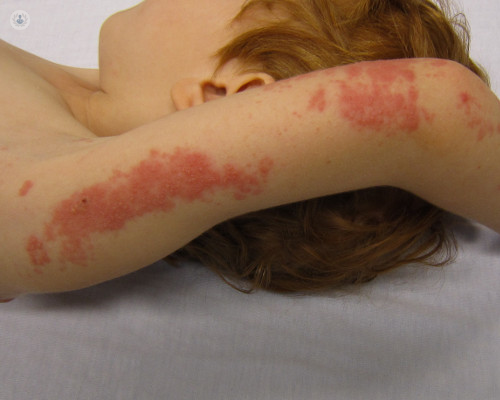


What is shingles?
Shingles is a viral infection that causes a tender and painful rash which most commonly presents either on the right or left hand side of the torso. You can also get shingles on your face, eyes and genitals. Shingles is not life-threatening, but it can cause a lot of pain and discomfort.
What are the symptoms of shingles?
The first signs of shingles is usually a pain felt in the area of skin, a headache and generally feeling unwell. A few days after these symptoms, a rash will present. The shingles rash is red, blotchy and appears on just one side of your body. The red blotches turn into small, itchy blisters that ooze fluid. Eventually these blisters dry out and form little scabs. Even after the rash has gone, the area of skin affected can remain painful. The rash can take up to 4 weeks to heal.
Other symptoms experienced with shingles include:
- fatigue
- sensitivity to light
- fever
What causes shingles?
Shingles is caused by the varicella-zoster virus, which is the same virus that causes the chickenpox. Anyone who has had chickenpox can develop shingles as the virus stays in your nervous system, remaining dormant for years. If the virus reactivates, it moves along the nerve pathways resulting in shingles. Shingles is not contagious to people who have had chickenpox.
For people who not had the chickenpox, exposure to shingles can cause them to come down with the chickenpox. This can be dangerous in older people, pregnant women, newborns and people with weakened immune systems.
How can shingles be prevented?
There are two vaccines that can help avoid shingles. The first is the chickenpox vaccine which is usually given to adults who have never had the chickenpox. This vaccine cannot guarantee you against the chickenpox, but it can significantly reduce your chances.
The second preventative measure is the shingles vaccine. This is available in the UK to people over the age of 70 or 78. This vaccine proved to be ineffective on people aged over 80 however. Even if you do contract shingles after the vaccine, the symptoms will be much milder.
For people with shingles, they should avoid work or school until the rash scabs over.
How is shingles treated?
To treat shingles, there are some techniques to relieve the discomfort, including:
- over-the-counter painkillers
- wearing loose-fitting clothing
- use cooling creams
- use a cool compress wrapped in a towel a few times a day
There are also a couple of measures to avoid:
- do not let plasters pr dressings stick to the rash
- do not use antibiotic cream as this slows the healing process
Although there is no cure for shingles, you can take anti-viral medication to reduce the risk of complications and to help the healing process. For people experiencing severe pain, prescription painkillers will be considered.
